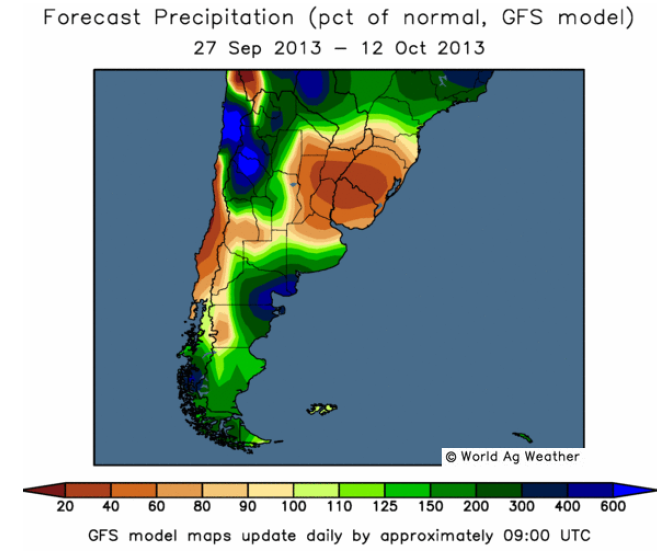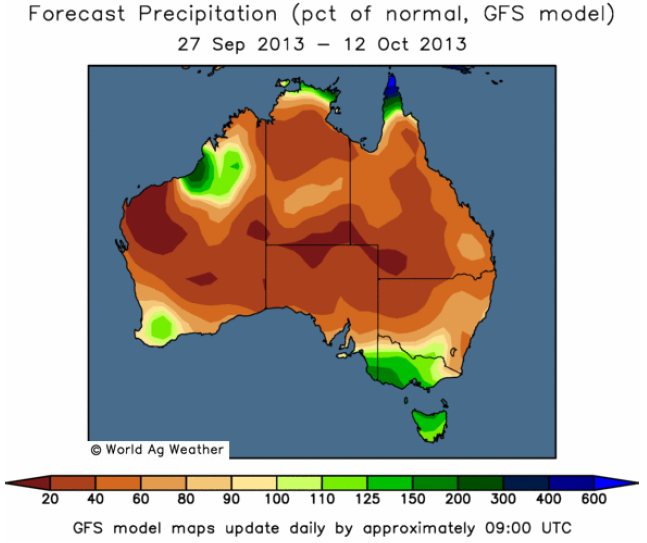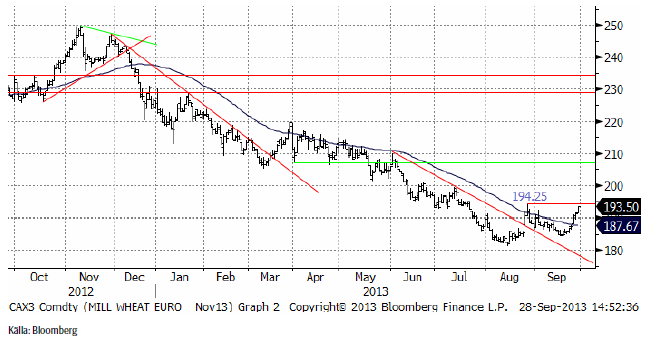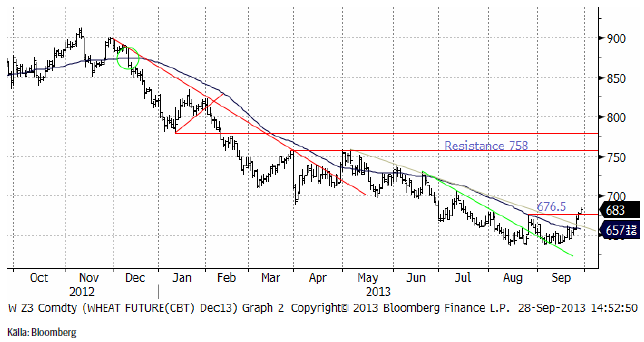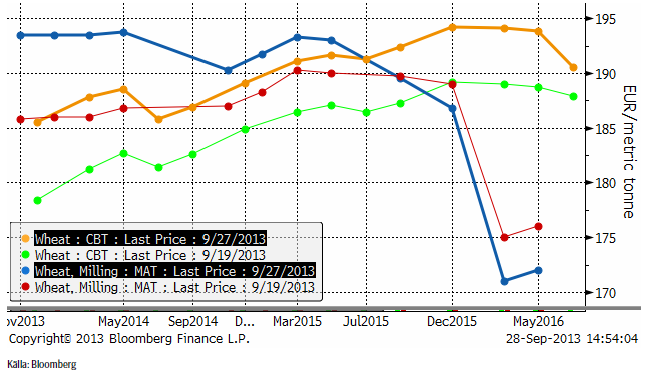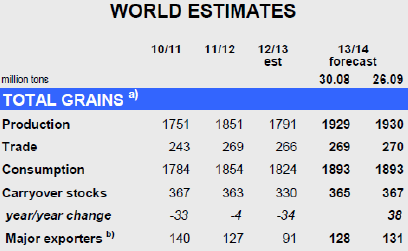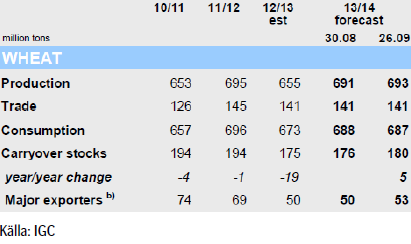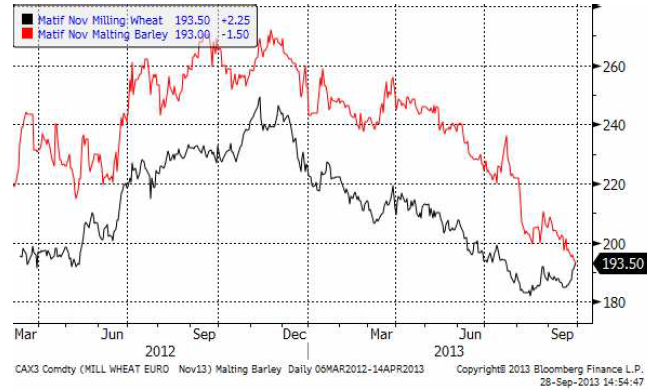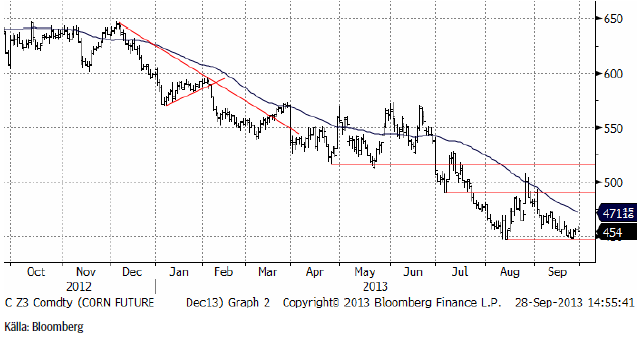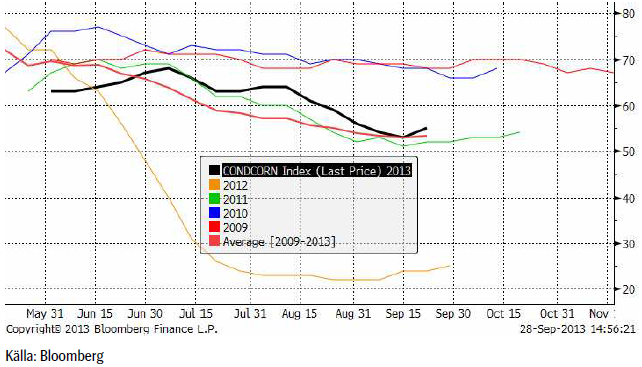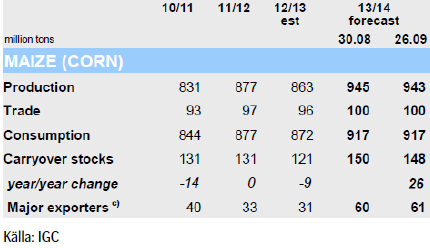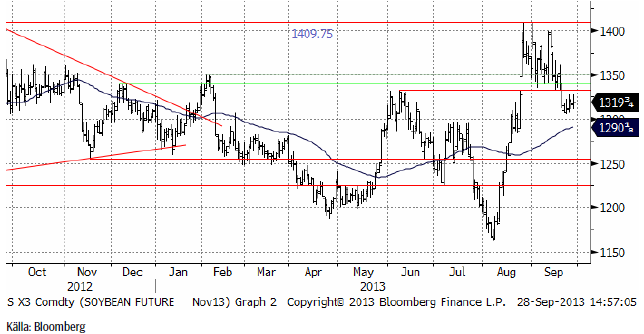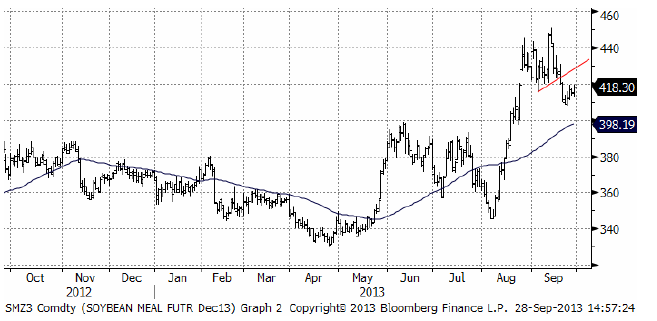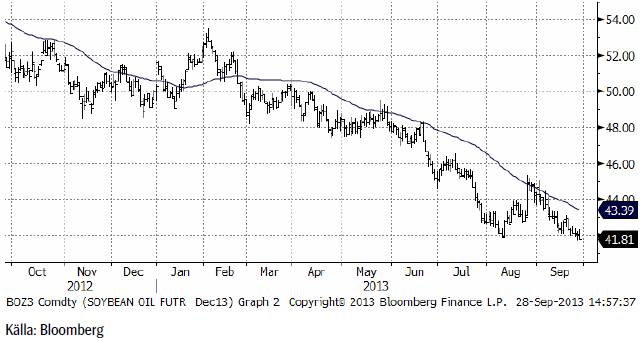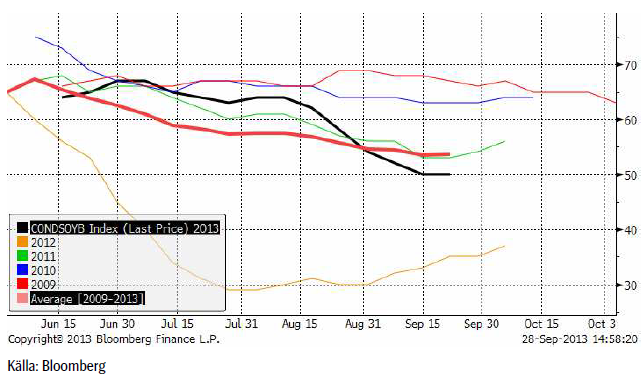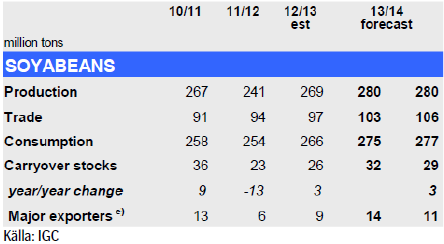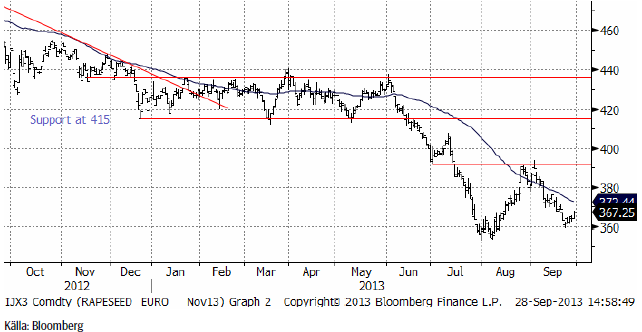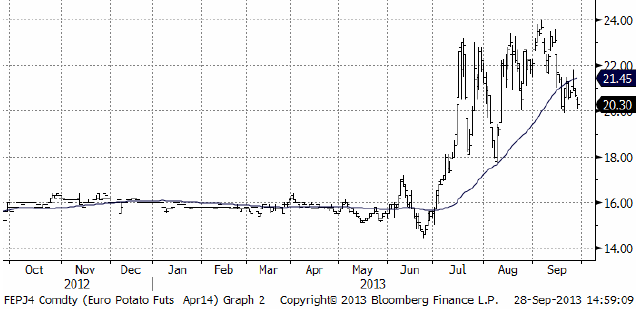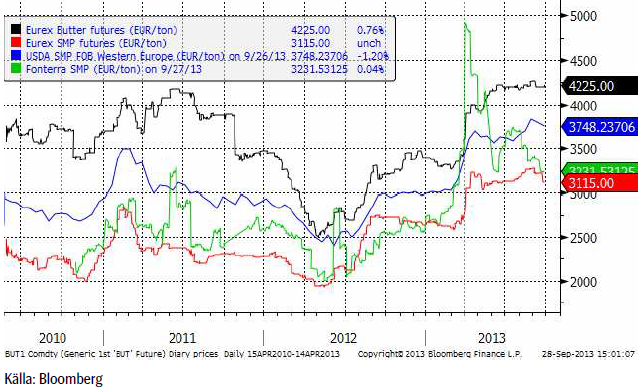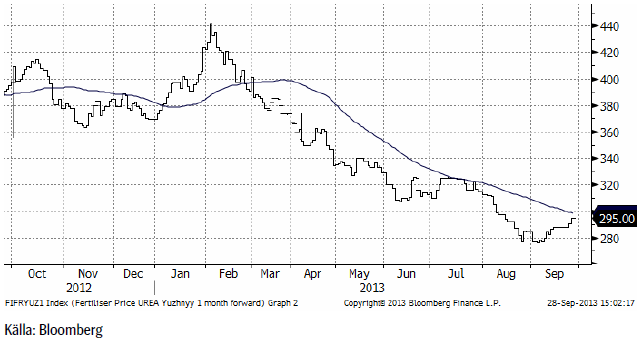Analys
SEB Jordbruksprodukter, 30 september 2013


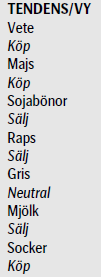 Vi anser att vi har tidiga tecken på en vändning uppåt i pristrenden för vete och majs. Därför byter vi rekommendation från neutral till köp på dessa. För oljeväxter har vi fortfarande säljrekommendation. Den tekniska analysen av sojamarknaden indikerar ett nytt stort prisfall från fredagens 1319 till 1250 cent per bushel.
Vi anser att vi har tidiga tecken på en vändning uppåt i pristrenden för vete och majs. Därför byter vi rekommendation från neutral till köp på dessa. För oljeväxter har vi fortfarande säljrekommendation. Den tekniska analysen av sojamarknaden indikerar ett nytt stort prisfall från fredagens 1319 till 1250 cent per bushel.
Den sista september är det dags att ta emot lagerstatistiken från USDA: hur stora lagren av spannmål och oljeväxter som fanns i USA den 1 september.
Estimaten hos marknaden är som följer:
Statistiken publiceras klockan 18:00 svensk tid.
Det är den så kallade Golden Week i Kina den här veckan, vilket innebär att affärslivet går på sparlåga där hela veckan.
Odlingsväder
Det kalla och torra vädret i Argentina väcker frågan om det är någon La Niña i vardande, men det är det inte som vi ser av ensemble-prognosen från Australiens Meteorologiska byrå nedan.
Det har ändå varit torrt och kallt i norra Argentina, så pass att frost befaras ha skadat nysått vete.
Australien har varit nästan helt torrt och väntas enligt den senaste prognosen med GFS-modellen vara fortsatt huvudsakligen torrt fram till mitten av oktober.
Vete
November månads terminskontrakt på Matif har arbetat sig upp mot motståndslinjen. Bryts den signaleras en stigande trend. Den fallande trenden är redan slut och vi har sedan mitten av augusti haft neutral rekommendation. Eftersom Chicagovetet har brutit motståndet redan (svagare dollar har inverkat), men är den viktigare börsen, går vi över till köprekommendation från och med det här veckobrevet. Vi skrev också förra veckan att förväntningarna på stigande pris helt saknas. Det finns alltså en god jordmån för stigande priser hos marknadens aktörer. De är av allt att döma tämligen oförberedda. Däremot tror vi inte just nu på att det finns stor potential på uppsidan, eftersom så många lantbrukare håller på sin spannmål och successivt kommer att sälja.
Decemberkontraktet på CBOT har brutit motståndet på 676.5 cent och därmed befinner sig marknaden enligt den tekniska analysen, i stigande trend.
Nedan ser vi terminskurvorna för Chicagovete och Matif.
Som vi ser är det framförallt de korta löptiderna som har gått upp på Matif. På Chicagobörsen har alla löptider gått upp i pris. Det råder nu backwardation på Matif-börsen, vilket är ett tecken på ”brist på material för omgående leverans”. Det är en återspegling av den höga exporttakten i kombination med att bönderna håller på materialet i förhoppning om högre pris – vilket indikerar att de ännu inte lärt sig att de i dessa lägen ska sälja sin vara spot och köpa den på termin – istället för att sitta kvar med sin spannmål.
Måndagens Crop Progress från USDA visar att skörden av amerikanskt vårvete går mot sitt slut. För de 6 stater som rapporterar så är nu 93% av skörden avklarad, en ökning från förra veckans 90%. Vid den här tiden förra året var dock skörden avklarad.
Sådden av amerikanskt höstvete går också framåt och 22% av den förväntade arealen var avklarad per den 22 september, upp från förra veckans 12 och i linje med förra året men en hårsmån lägre än det 5-åriga genomsnittet på 24%.
IGC (International Grains Council) kom med sin rapport i förra veckan och har ökat sitt estimat för den globala spannmålsproduktionen 2013/14 med 1 mt till 1930 mt. Tack vare gynnsamma väderförhållanden hos de stora producenterna, framförallt i USA och OSS, så bidrar detta till en förväntad ökning med 8% på årsbasis från 2012 års produktion då torka drabbade stor del av grödorna. Utgående lager justeras upp med 2 mt till 367 mt.
För vete indikeras en global produktion på 693 mt, vilket är en ökning med 2 mt från förra månaden och som nu kommer än närmare rekordnivån under 2011/12. Revideringen återspeglar högre produktion i Europa och OSS, vilket ger en ökning med 6% på årsbasis. USDA’s nuvarande estimat ligger på 708.9 mt.
Utgående lager förväntas öka med 5 mt på årsbasis till 180 mt som en följd av högre lager hos de stora exportländerna samt Kina.
Det är en typisk IGC-rapport. IGC börjar året lågt och höjer successivt estimaten. IGC:s ”sanning” måste alltid modifieras och man vet egentligen inte hur mycket som den behöver justeras.
Kinas CNGOIC höjde i veckan sitt importestimat med 1 mt till 7.5 mt. De har redan köpt 6.1 mt. Man kan tolka detta som att översvämningen i norra Kina faktiskt haft en negativ effekt, precis som vi skrivit att den skulle ha. Priset på vete i Kina är på rekordhög nivå.
Argentina har drabbats av frost i norra delen av landet, där vete odlas. Australien är torrt och priset på vete där har handlats upp.
Högproteinvete i norra Europa steg i pris förra veckan. Vete med 14% protein och över handlades 25 euro över Matif i norra Tyskland. 12% protein handlades 12 euro över.
Det blev mycket vårvete skördat i år, men skördarna blev så stora att kvaliteten på gluten har blivit sämre, erfar vi.
Förra veckan skrev vi om att de höga sojapriserna bidrar till en ökad odling av soja i USA nästa år på bekostnad av majs och vete. Vi kan se av de låga kvävegödselpriset att efterfrågan har varit svag, vilket tyder på att valet av soja redan är gjort. Detta leder till minskat utbud av spannmål och därmed ett högre pris. Tekniskt har vi köpsignal i Chicagovetet och vi tror att Matif kommer att följa efter. Därför går vi över till
köprekommendation.
Maltkorn
Terminspriset (november) ligger nu under matifvetet (november). Det trodde vi inte skulle kunna ske, men det kunde det. Uppenbarligen finns det så väldigt mycket maltkorn i Europa, efter att så stor areal blev vårsådd. Vi vet också att höstsådden i år har skett med religiös nit, vilket tyder på att maltkornet kan få revansch nästa år.
Majs
Majspriset (december 2013) är nere på det tekniska stödet och vi tror att det kommer att hålla. Bryts det, ska man naturligtvis ha en stop-loss strax under.
Tillståndet för den amerikanska majsen förbättrades under förra veckan enligt måndagens Crop Progress från USDA. För de 18 stater som rapporterar så klassas nu 55% som ”good/excellent”, en ökning med 2% från veckan innan och nu marginellt över det 5-åriga genomsnittet på 54%.
Omkring 58% respektive 64% av grödorna i Illinois och Indiana klassas som ”good/excellent”, vilket är en förbättring jämfört med veckan innan för Illinois. Iowa ligger fortfarande kvar på en låg nivå, endast 37%, men även här är det en ökning med 2% från veckan innan.
Grödornas sena utveckling i år börjar nu visa sig i skördestatistiken. Enligt USDA var endast 7% av skörden avklarad per den 22 september jämfört med det 5-åriga genomsnittet på 16%. Tar man en närmare titt på ”Istaterna” så var bara 3% av Iowas skörd klar jämfört med snittet på 9%, medan endast 5% av skörden i Illinois var klar jämfört med det 5-åriga genomsnittet på 24% vid den här tiden.
IGC rapporterade i veckan som gick. Den globala produktionen av majs beräknas uppgå till 943 mt, vilket är en minskning med 2 mt sedan IGC’s förra rapport men fortfarande nytt rekord och en ökning med 9% på årsbasis. Utgående lager justeras också ner med 2 mt sedan augusti, men 148 mt är fortfarande väl över genomsnittet och lagren hos de största exportörerna (Argentina, Brasilien, Ukraina och USA) estimeras till ett 26-års högsta.
Cofco, det kinesiska livsmedelsföretaget, prognosticerade att Kinas självförsörjningsgrad på majs kommer att sjunka till 90% fram till år 2020. Det är nog mot den bakgrunden man ska se den förvirrade rapporteringen i veckan som gick om att ett kinesiskt företag köpt 5% av Ukraina.
Vi anser att priset har fallit tillräckligt och går över till köprekommendation.
Sojabönor
Novemberkontraktet på sojabönor uppvisar en så kallad ”flagga” enligt den tekniska analysen. Det är den lilla rekylen uppåt vi ser i prisdiagrammet efter prisfallet från 1350 cent. ”Flaggor” brukar ofta etableras halvvägs i en rörelse. Halvvägs mäts i det här fallet från 1400 till 1300 cent. Det finns alltså, enligt den tekniska analysen, ytterligare 100 cent till på nedsidan att göra färdigt. Det skulle ta priset ner till åtminstone 1250, kanske rentav till 1225 cent.
Sojamarknaden är naturligt uppdelad på sojamjöl och sojaolja och det är två helt olika världar. Sojamjölet uppvisar samma ”flagga” som i sojabönorna och vi tror att det kommer ett nytt kraftigt prisfall den här veckan.
Och nedan ser vi den mycket baissigare utvecklingen på sojaoljan. Priset ligger på en teknisk stödnivå.
Marknadens förväntningar på att USDA skulle justera upp tillståndet för sojabönor, efter förra veckans spridda regnskurar, kom av sig efter måndagens Crop Progress rapport där USDA istället lämnade siffrorna oförändrade för ”good/excellent” på 50%. Hälften av grödorna i Illinois klassas som ”good/excellent”, och i Indiana ligger siffran på 58%. För Iowa ligger siffran på blygsamma 34%. För Indiana och Iowa är detta en ökning med 1%-2% från veckan innan.
IGC rapporterade i veckan som gick. För sojabönor förväntas den globala produktionen att stiga för andra året i rad till rekordhöga 280 mt för 2013/14, en ökning med 4% på årsbasis, framförallt tack vare estimerade jätteskördar i Sydamerika. Globala utgående lager justeras ner med 3 mt från förra månaden till 29 mt, vilket bl.a reflekterar fortsatta nedjusteringar för USA, men beräknas öka med 12% på årsbasis med de stora exportörerna Argentina och Brasilien i täten. Den globala handeln med sojabönor väntas expandera med 9% på årsbasis drivet av en fortsatt stark efterfrågan från Kina (med en ökad import på 14%).
Den globala produktionen av raps / canola beräknas öka med 5% på årsbasis under 2013/14 till rekordhöga 66.5 mt, samtidigt som utgående lager beräknas öka med 17% på årsbasis – den första uppgången på 4 år.
Vi behåller säljrekommendation.
Raps
Rapspriset (november 2013) fann stöd på 360 euro, men vi tror att den rekyl som följde efter det kommer att bli kort och att ett nytt test av 360 euro är förestående.
Att EU beslutat att lägga sig på 5% inblandning av biodiesel istället för 10%, tror vi inte fullt ut återspeglas i priserna än. Det finns de som lyckas visa att biobränsleefterfrågan inte haft någon påverkan på priserna, men det är ganska lätt att visa att de har haft det och har det även när biobränsleefterfrågan minskar.
Vi behåller säljrekommendationen på raps.
Potatis
Potatispriset av årets skörd, som handlas i april-kontraktet på Eurex, har fortsatt varit volatilt i veckan. Efter en ganska stor prisuppgång, föll priset tillbaka och stängde veckan på 20.30 euro per deciton. Det finns intresse för nästa års skörd, som alltså handlas på april 2015-kontraktet, men handeln har ännu inte riktigt kommit igång.
VD:n för brittiska firman Greenvale sade i veckan att Storbritannien kommer att behöva importera potatis i år. Odlad areal i Storbritannien blev låg i en historisk jämförelse. Shore Capital, en mäklarfirma, prognosticerade skörden till 5.3 mt, högre än förra årets 4.5 mt. Det historiska medelvärdet är 6 mt. Konsumtionen uppgår till ca 5.7 mt / år, vilket innebär att det finns ett importbehov. På grund av den torra sommaren i norra Europa finns sannolikt ett underskott även här.
Odlingen i EU har minskat med 40 mha till 1 775 mha i år enligt den tyska jordbrukarorganisationen DBV. Polen är den största producenten med 350,000 ha, följt av Tyskland och Rumänien.
Gris
Prist på Lean Hogs fortsatte att stiga i veckan, men trenden ser ut att ha tappat momentum. Slaktstatistiken visar på minskad utslaktning. Det talas i USA om spridningen av PEDv-viruset och nyheterna tyder på att minskningen är relaterad till sjukdomar eller rädsla för spridning av sjukdomar i USA.
I Kina är priserna relativt höga i ett historiskt perspektiv.
Å andra sidan förbättras marginalerna nu, när foderpriserna faller och priset på kött stiger.
Mjölk
Terminerna på smör och skummjölkspulver vid Eurex-börsen var lite försiktigare i veckan som gick. Medan priset på smör behöll sin nivå, föll SMP relativt kraftigt. Fonterra-noteringen fortsatte gå ner i rask takt.
Socker
Marskontraktet på råsocker föll kraftigt i fredags, efter att inte ha orkat ta sig över toppen från juni. Rädslan uppstod när det stod klart att det blir stora leveranser på oktoberkontraktet som förfaller på måndag.
Thailand prognosticerar en produktion om 11 mt. Det är högre än ISO estimerat, men mindre än analysfirman Kingsman.
Ytterligare negativa nyheter kom från Brasilien, där konsultfirman Job Economia flaggade för att Brasilien kan tänka sig att importera etanol från USA.
Vi fortsätter dock att ha en positiv vy på prisutvecklingen framöver. Priset har gått ner i nästan tre år och har troligtvis en lång uppgångsfas framför sig. En rekyl nedåt mot 17 cent på marskontraktet betraktar jag som ett köptillfälle.
Gödsel
Priset på kväve / urea fortsatte att sega sig uppåt i veckan som gick. Priset noteras nu 15 dollar högre per ton på 295 dollar.
[box]SEB Veckobrev Jordbruksprodukter är producerat av SEB Merchant Banking och publiceras i samarbete och med tillstånd på Råvarumarknaden.se[/box]
Disclaimer
The information in this document has been compiled by SEB Merchant Banking, a division within Skandinaviska Enskilda Banken AB (publ) (“SEB”).
Opinions contained in this report represent the bank’s present opinion only and are subject to change without notice. All information contained in this report has been compiled in good faith from sources believed to be reliable. However, no representation or warranty, expressed or implied, is made with respect to the completeness or accuracy of its contents and the information is not to be relied upon as authoritative. Anyone considering taking actions based upon the content of this document is urged to base his or her investment decisions upon such investigations as he or she deems necessary. This document is being provided as information only, and no specific actions are being solicited as a result of it; to the extent permitted by law, no liability whatsoever is accepted for any direct or consequential loss arising from use of this document or its contents.
About SEB
SEB is a public company incorporated in Stockholm, Sweden, with limited liability. It is a participant at major Nordic and other European Regulated Markets and Multilateral Trading Facilities (as well as some non-European equivalent markets) for trading in financial instruments, such as markets operated by NASDAQ OMX, NYSE Euronext, London Stock Exchange, Deutsche Börse, Swiss Exchanges, Turquoise and Chi-X. SEB is authorized and regulated by Finansinspektionen in Sweden; it is authorized and subject to limited regulation by the Financial Services Authority for the conduct of designated investment business in the UK, and is subject to the provisions of relevant regulators in all other jurisdictions where SEB conducts operations. SEB Merchant Banking. All rights reserved.
Analys
Tightening fundamentals – bullish inventories from DOE

The latest weekly report from the US DOE showed a substantial drawdown across key petroleum categories, adding more upside potential to the fundamental picture.

Commercial crude inventories (excl. SPR) fell by 5.8 million barrels, bringing total inventories down to 415.1 million barrels. Now sitting 11% below the five-year seasonal norm and placed in the lowest 2015-2022 range (see picture below).
Product inventories also tightened further last week. Gasoline inventories declined by 2.1 million barrels, with reductions seen in both finished gasoline and blending components. Current gasoline levels are about 3% below the five-year average for this time of year.
Among products, the most notable move came in diesel, where inventories dropped by almost 4.1 million barrels, deepening the deficit to around 20% below seasonal norms – continuing to underscore the persistent supply tightness in diesel markets.
The only area of inventory growth was in propane/propylene, which posted a significant 5.1-million-barrel build and now stands 9% above the five-year average.
Total commercial petroleum inventories (crude plus refined products) declined by 4.2 million barrels on the week, reinforcing the overall tightening of US crude and products.


Analys
Bombs to ”ceasefire” in hours – Brent below $70

A classic case of “buy the rumor, sell the news” played out in oil markets, as Brent crude has dropped sharply – down nearly USD 10 per barrel since yesterday evening – following Iran’s retaliatory strike on a U.S. air base in Qatar. The immediate reaction was: “That was it?” The strike followed a carefully calibrated, non-escalatory playbook, avoiding direct threats to energy infrastructure or disruption of shipping through the Strait of Hormuz – thus calming worst-case fears.

After Monday morning’s sharp spike to USD 81.4 per barrel, triggered by the U.S. bombing of Iranian nuclear facilities, oil prices drifted sideways in anticipation of a potential Iranian response. That response came with advance warning and caused limited physical damage. Early this morning, both the U.S. President and Iranian state media announced a ceasefire, effectively placing a lid on the immediate conflict risk – at least for now.
As a result, Brent crude has now fallen by a total of USD 12 from Monday’s peak, currently trading around USD 69 per barrel.
Looking beyond geopolitics, the market will now shift its focus to the upcoming OPEC+ meeting in early July. Saudi Arabia’s decision to increase output earlier this year – despite falling prices – has drawn renewed attention considering recent developments. Some suggest this was a response to U.S. pressure to offset potential Iranian supply losses.
However, consensus is that the move was driven more by internal OPEC+ dynamics. After years of curbing production to support prices, Riyadh had grown frustrated with quota-busting by several members (notably Kazakhstan). With Saudi Arabia cutting up to 2 million barrels per day – roughly 2% of global supply – returns were diminishing, and the risk of losing market share was rising. The production increase is widely seen as an effort to reassert leadership and restore discipline within the group.
That said, the FT recently stated that, the Saudis remain wary of past missteps. In 2018, Riyadh ramped up output at Trump’s request ahead of Iran sanctions, only to see prices collapse when the U.S. granted broad waivers – triggering oversupply. Officials have reportedly made it clear they don’t intend to repeat that mistake.
The recent visit by President Trump to Saudi Arabia, which included agreements on AI, defense, and nuclear cooperation, suggests a broader strategic alignment. This has fueled speculation about a quiet “pump-for-politics” deal behind recent production moves.
Looking ahead, oil prices have now retraced the entire rally sparked by the June 13 Israel–Iran escalation. This retreat provides more political and policy space for both the U.S. and Saudi Arabia. Specifically, it makes it easier for Riyadh to scale back its three recent production hikes of 411,000 barrels each, potentially returning to more moderate increases of 137,000 barrels for August and September.
In short: with no major loss of Iranian supply to the market, OPEC+ – led by Saudi Arabia – no longer needs to compensate for a disruption that hasn’t materialized, especially not to please the U.S. at the cost of its own market strategy. As the Saudis themselves have signaled, they are unlikely to repeat previous mistakes.
Conclusion: With Brent now in the high USD 60s, buying oil looks fundamentally justified. The geopolitical premium has deflated, but tensions between Israel and Iran remain unresolved – and the risk of missteps and renewed escalation still lingers. In fact, even this morning, reports have emerged of renewed missile fire despite the declared “truce.” The path forward may be calmer – but it is far from stable.
Analys
A muted price reaction. Market looks relaxed, but it is still on edge waiting for what Iran will do

Brent crossed the 80-line this morning but quickly fell back assigning limited probability for Iran choosing to close the Strait of Hormuz. Brent traded in a range of USD 70.56 – 79.04/b last week as the market fluctuated between ”Iran wants a deal” and ”US is about to attack Iran”. At the end of the week though, Donald Trump managed to convince markets (and probably also Iran) that he would make a decision within two weeks. I.e. no imminent attack. Previously when when he has talked about ”making a decision within two weeks” he has often ended up doing nothing in the end. The oil market relaxed as a result and the week ended at USD 77.01/b which is just USD 6/b above the year to date average of USD 71/b.

Brent jumped to USD 81.4/b this morning, the highest since mid-January, but then quickly fell back to a current price of USD 78.2/b which is only up 1.5% versus the close on Friday. As such the market is pricing a fairly low probability that Iran will actually close the Strait of Hormuz. Probably because it will hurt Iranian oil exports as well as the global oil market.
It was however all smoke and mirrors. Deception. The US attacked Iran on Saturday. The attack involved 125 warplanes, submarines and surface warships and 14 bunker buster bombs were dropped on Iranian nuclear sites including Fordow, Natanz and Isfahan. In response the Iranian Parliament voted in support of closing the Strait of Hormuz where some 17 mb of crude and products is transported to the global market every day plus significant volumes of LNG. This is however merely an advise to the Supreme leader Ayatollah Ali Khamenei and the Supreme National Security Council which sits with the final and actual decision.
No supply of oil is lost yet. It is about the risk of Iran closing the Strait of Hormuz or not. So far not a single drop of oil supply has been lost to the global market. The price at the moment is all about the assessed risk of loss of supply. Will Iran choose to choke of the Strait of Hormuz or not? That is the big question. It would be painful for US consumers, for Donald Trump’s voter base, for the global economy but also for Iran and its population which relies on oil exports and income from selling oil out of that Strait as well. As such it is not a no-brainer choice for Iran to close the Strait for oil exports. And looking at the il price this morning it is clear that the oil market doesn’t assign a very high probability of it happening. It is however probably well within the capability of Iran to close the Strait off with rockets, mines, air-drones and possibly sea-drones. Just look at how Ukraine has been able to control and damage the Russian Black Sea fleet.
What to do about the highly enriched uranium which has gone missing? While the US and Israel can celebrate their destruction of Iranian nuclear facilities they are also scratching their heads over what to do with the lost Iranian nuclear material. Iran had 408 kg of highly enriched uranium (IAEA). Almost weapons grade. Enough for some 10 nuclear warheads. It seems to have been transported out of Fordow before the attack this weekend.
The market is still on edge. USD 80-something/b seems sensible while we wait. The oil market reaction to this weekend’s events is very muted so far. The market is still on edge awaiting what Iran will do. Because Iran will do something. But what and when? An oil price of 80-something seems like a sensible level until something do happen.
-

 Nyheter4 veckor sedan
Nyheter4 veckor sedanStor uppsida i Lappland Guldprospekterings aktie enligt analys
-

 Nyheter4 veckor sedan
Nyheter4 veckor sedanSilverpriset släpar efter guldets utveckling, har mer uppsida
-

 Nyheter3 veckor sedan
Nyheter3 veckor sedanUppgången i oljepriset planade ut under helgen
-

 Nyheter2 veckor sedan
Nyheter2 veckor sedanMahvie Minerals växlar spår – satsar fullt ut på guld
-

 Nyheter3 veckor sedan
Nyheter3 veckor sedanLåga elpriser i sommar – men mellersta Sverige får en ökning
-

 Analys3 veckor sedan
Analys3 veckor sedanVery relaxed at USD 75/b. Risk barometer will likely fluctuate to higher levels with Brent into the 80ies or higher coming 2-3 weeks
-

 Nyheter2 veckor sedan
Nyheter2 veckor sedanOljan, guldet och marknadens oroande tystnad
-

 Nyheter2 veckor sedan
Nyheter2 veckor sedanJonas Lindvall är tillbaka med ett nytt oljebolag, Perthro, som ska börsnoteras




